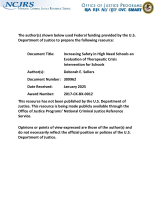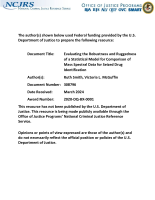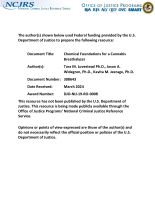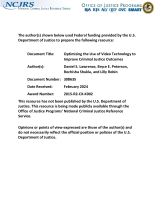Evaluation Techniques
Reducing Fear of Crime in Houston and Newark - A Summary Report
Evaluation of Alternative Methods for DNA Recovery of Compromised Skeletal Remains
Counselor Knows Best? Clinician Assessments of In-Prison Substance Abuse Treatment Participants
Increasing Safety in High Need Schools: An Evaluation of Therapeutic Crisis Intervention for Schools
MEASUREMENT PRACTICE IN INTENSIVE AND SPECIAL ADULT PROBATION
MEASUREMENT OF POLICE OUTPUT - CONCEPTUAL ISSUES AND ALTERNATIVE APPROACHES
Standard Reference Material 2372a Human DNA Quantitation Standard
ASSAULTIVE YOUTH - AN EXPLORATORY STUDY OF THE ASSAULTIVE EXPERIENCE AND ASSAULTIVE POTENTIAL OF CALIFORNIA YOUTH AUTHORITY WARDS
Evaluation of Community-Based Violence Intervention and Prevention Initiatives (CVIPI) in New Haven, CT
Early Intervention for Victims of Crime: Evaluation of Skills for Psychological Recovery
Multi-level, Mixed Methods Evaluation of Elm City COMPASS: A Comprehensive Approach to 911 Crisis Response
Improving police-public relationships through intergroup contact: A mixed-methods evaluation of the Voices communication intervention
Does Training Police Officers In Brazilian Jiu-Jitsu Improve Use Of Force Outcomes? An Experimental Evaluation With Systematic Social Observation in the Colorado Springs Police Department
Assessing the Impact of an Innovative Response to Intimate Partner Violence Related Strangulation, Process Evaluation
Assessing the Impact of an Innovative Response to Intimate Partner Violence Related Strangulation, Final Report & Outcome Evaluation
Redesigning Life in U.S. Prisons
The prison system in the U.S. typically places a heavy emphasis on security, control, and punishment, and this foundation can create an adversarial culture within correctional facilities — incarcerated individuals versus correctional staff. But what if that culture could change? What would it look like? How would it impact not only incarcerated individuals but also correctional officers and other staff?
Evaluating the Effects of Co-response Teams in Reducing Subsequent Hospitalization: A Place-based Randomized Controlled Trial
FITS—Functional Implementation of Thorough and Systematic Approaches for Fracture Examinations
,







